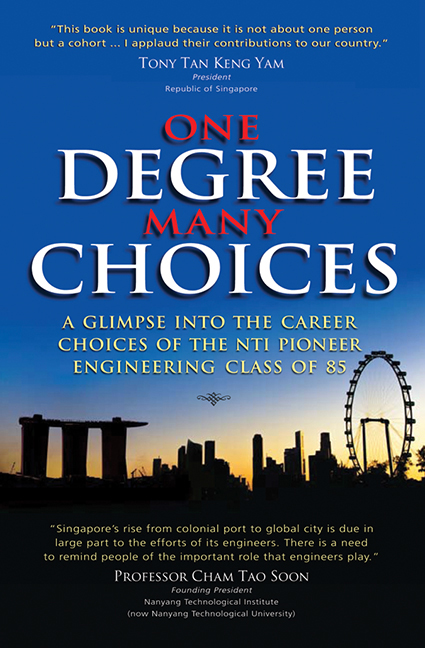 One Degree, Many Choices
One Degree, Many Choices from PART II - ENGINEERING PURSUITS
Published online by Cambridge University Press: 21 October 2015
“Astrong engineering foundation gave me the confidence to take on such varied roles in an MNC like Lucent Technologies.”
— Henry Tan Chin Tuan, EEE PioneerTHE FORTUNES OF EEE PIONEER Winston Choo York Meng's company read like a recent history of Singapore's telecommunications industry. In 1995, the bulk of his company's business came from building equipment for SingTel telex department. Telex is a switched network of teleprinters similar to a telephone network. It sends out text based messages. In those days, every major company and banks had a telex machine and a dedicated telex operator. However, the facsimile machine and e-mail eroded the usefulness of the high-cost telex. Less and less business rolled in and SingTel discontinued the service in 2009.
Due to the decline in telex jobs, Winston's company found new contracts in the paging sector dominated by SingTel, Hutchinson and Easy call. In the heyday between 1994 and 2002, there were more than two million pagers in use. With the end of SingTel's monopoly in 1995, the number of mobile phone users shot up at the expense of pagers. In 2005, the number of people using pagers dropped to half a million. The writing was on the wall. Easy call closed their paging service in 2004 and SingTel in 2008.
In 1997, Winston got onto the mobile phone bandwagon with business from Motorola and Ericsson which supplied cellular equipment to SingTel and M1. Unfortunately, it was not a smooth ride. By 2005, China's telecommunication equipment builder Huawei was competing with Motorola and Ericsson. Now, the local telecommunication companies use Huawei's products. That reduced Winston's business drastically. His involvement with this sector is now limited to a short messaging system gateway service targeting industrial users. Winston has since diversified into the military equipment and railway equipment business. His efforts made a modest contribution to the development of Singapore's telecommunication infrastructure, one of the most advanced in the world. Singapore is recognised globally as a leader in the development and use of Information and Communications Technology.
In contrast to Winston's experience, fellow pioneer Leong Peng Ham rode on the wave of change in the telecommunication industry to greater heights. Peng Ham was in the thick of action at the Telecommunication Authority of Singapore (TAS). The agency gave him a scholarship to study at NTI and a job upon graduation.
To save this book to your Kindle, first ensure no-reply@cambridge.org is added to your Approved Personal Document E-mail List under your Personal Document Settings on the Manage Your Content and Devices page of your Amazon account. Then enter the ‘name’ part of your Kindle email address below. Find out more about saving to your Kindle.
Note you can select to save to either the @free.kindle.com or @kindle.com variations. ‘@free.kindle.com’ emails are free but can only be saved to your device when it is connected to wi-fi. ‘@kindle.com’ emails can be delivered even when you are not connected to wi-fi, but note that service fees apply.
Find out more about the Kindle Personal Document Service.
To save content items to your account, please confirm that you agree to abide by our usage policies. If this is the first time you use this feature, you will be asked to authorise Cambridge Core to connect with your account. Find out more about saving content to Dropbox.
To save content items to your account, please confirm that you agree to abide by our usage policies. If this is the first time you use this feature, you will be asked to authorise Cambridge Core to connect with your account. Find out more about saving content to Google Drive.